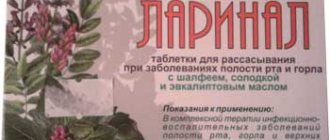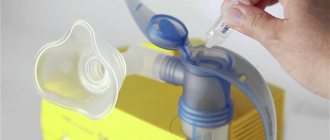Causes of sore throat
Inflammatory. The most common cause of a sore throat and dry cough is acute respiratory diseases. These are infections caused by various pathogens:
- viruses (parainfluenza, influenza, respiratory syncytial virus, enterovirus);
- bacteria (streptococci, staphylococci);
- fungi (for example, yeast of the genus Candida).
Infections are transmitted mainly by airborne droplets, as well as by contact. Their maximum incidence is observed in the cold and damp seasons. An infectious agent, penetrating the body, is fixed on the mucous membranes of the respiratory tract, where, in response to its penetration, a protective reaction in the form of inflammation is triggered. Swelling and redness of the mucous membrane develop, leading to discomfort, pain and sore throat, causing coughing.
Non-inflammatory. A sore throat and dry cough can also occur with non-inflammatory damage to the mucous membranes of the upper respiratory tract:
- for allergic pharyngitis, laryngotracheitis, bronchitis;
- thermal irritation of the respiratory tract (inhalation of hot or cold air);
- irritation from chemical agents (ingress of particles and vapors of varnishes, paints, household chemicals, gasoline, etc.);
- strong vocal stress (“lecturer’s” laryngitis);
- smoking;
- injury or foreign body entering the lumen of the larynx, pharynx, trachea.
In addition to respiratory diseases, tickling and dry cough may occur:
- against the background of the use of certain medications (ACE inhibitors, diuretics);
- with heart failure;
- hypothyroidism and after surgery on the thyroid gland (damage to the laryngeal nerve leads to hoarseness, sore throat without coughing);
- diabetes mellitus;
- neuroses.
Throat treatment with inhalations
When inhaled, beneficial substances enter the body with steam or gas. In medicine, inhalations with drugs are used, and at home, essential oils, mineral water, salt, and soda are used for this.
How to quickly cure a throat with inhalations? At home, you can use inhalers and a nebulizer. If you don’t have special equipment, you can breathe steam over a saucepan or kettle.
Throat treatment with inhalations: Pixabay
At home, you can prepare inhalation with eucalyptus, clove, and tea tree oil. To do this, you need to boil water and add a few drops of essential oil to it. Then sit over a saucepan or kettle, without touching the heated surfaces, cover your head with a towel and take a deep breath. Continue the procedure until the water cools down. Essential oils have an antiseptic effect, soften the throat and make breathing easier.
You can also boil mineral water or make a solution with soda. To do this, you will need still water and 1 teaspoon of soda per liter.
Treatment options
To effectively treat dryness, sore throat and cough, it is necessary first of all to act on the cause of their occurrence - inflammation. To make an accurate diagnosis, you should consult a doctor who, depending on the anamnesis (history of the development of the disease), complaints and examination, will immediately suggest a particular disease or prescribe additional examinations and consultations. Since dryness, tickling and cough are not a diagnosis, but only one of the symptoms of the disease, it is necessary to carry out comprehensive treatment, and not limit ourselves to just eliminating unpleasant symptoms. Elimination of pathogens.
In case of infectious origin of tickling and cough, therapy is prescribed that acts on the pathogen - antiviral, antibacterial or antifungal drugs for systemic use (orally or by injection, in the form of rectal suppositories). The selection of an antibiotic or antiviral agent is carried out by a doctor. Under no circumstances should you independently cancel and replace one drug with another or stop taking it earlier - this can lead to the progression of the process or its transition to a chronic stage.
Pain relief
. However, cough and severe sore throat, as a rule, are subjectively difficult for patients to tolerate, causing severe discomfort and disrupting their usual way of life. Therefore, it is difficult to do without the use of symptomatic medications to reduce the severity of complaints. For this purpose, a variety of local remedies are used: tablets and lozenges, sprays, rinsing solutions. If your throat is very sore, frequent warm drinks, warming and distracting procedures can help soothe the irritation of the mucous membranes. If you have a painful, obsessive, prolonged non-productive cough, you may need to prescribe antitussive drugs.
Diagnosis of pathology
Making a diagnosis begins with an examination by a therapist, collecting complaints, and taking an anamnesis. After this, a general blood test is prescribed.
If the cause cannot be established, the patient is referred to an otolaryngologist, endocrinologist and allergist, as well as for a consultation with a neurologist. You will need to additionally take a blood test for immunoglobulin E, a throat smear, and an ultrasound of the thyroid gland.
If the cause of the condition is not found, a consultation with a gastroenterologist and esophagogastroduodenoscopy is prescribed. Based on the results obtained, treatment is prescribed.
Doctor MOM® for the treatment of cough and sore throat
In the complex treatment of cough and sore throat, the use of herbal medicines from the Doctor MOM® line - syrup and herbal cough lozenges - is indicated. Thanks to the unique1 “FITO BRONHO formula”2 based on medicinal plant extracts, the products in the Doctor MOM® line have a complex effect, helping to both relieve unpleasant symptoms and eliminate their cause - inflammation.
The main actions of Doctor MOM® syrup and herbal cough lozenges are:
- Eliminating the cause of cough – inflammation;
- Removing infection from the body3;
- Combating unproductive and unproductive cough.
Features of infection and symptoms
The pharynx is a tube 15 cm long. The upper part goes into the nose and mouth, the lower part into the esophagus. The digestive and respiratory tracts intersect in the middle. Through the Eustachian tube, the nasopharynx communicates with the middle ear, due to which the pressure in the ears is normalized. The tonsils are located on the back wall of the nasopharynx. During the period of inflammation, they increase and cause certain troubles. All these organs are interconnected, so the defeat of one may mean the imminent defeat of another.
During the inflammatory process, the body turns on defense, but it has peculiar manifestations that we are trying to get rid of. We are talking about swelling, pain, and poor functioning of the body as a whole. These signs also exist during the inflammatory process of the nasopharynx. The mucous membrane immediately becomes infected, the blood vessels dilate, and redness occurs in the affected area. Then swelling appears and it becomes painful because the tissues swell.
There are also viral inflammatory processes that are caused by viruses. In these cases, the mucous membrane of the throat swells and turns red. The temperature rises, the throat hurts, and the lymph nodes become enlarged.
But bacterial inflammation is a complication of a viral one or occurs as a new infection. In such cases, there is a cutting pain that radiates to the ears. Swelling of the mucous membrane, redness, and the appearance of a white coating appear. To diagnose this disease, a swab is taken from the throat.
Inflammation in the nasopharynx - symptoms and treatment
Is it possible to do inhalations for a sore throat?
Using a nebulizer for a sore throat is a completely reasonable decision, since this method helps to quickly relieve inflammation and remove plaque. However, the procedure should be carried out only after consultation with a doctor who selects medications and their dosage.
Sore throat is a type of tonsillitis, i.e. inflammation in the tonsils. The disease is accompanied by severe discomfort and pain when swallowing, redness of the tonsils, an increase in their volume, the appearance of purulent plugs, ulcers, and white plaque.
Inhalations for sore throat are prescribed as an addition to rinsing and taking medications. There are several reasons to use such a device:
- Inhalations can reduce the duration of the acute phase of the disease and the time of taking medications, as well as their doses;
- Impact on the respiratory tract prevents dangerous complications that often develop against the background of sore throat;
- The procedure helps relieve pain and stops the inflammatory process;
- Inhalation thins the mucus coming out of the nose, relieves swelling in the nasal sinuses and makes breathing easier.
Inhalations for angina accelerate the healing of damaged tissues and generally contribute to a rapid recovery.
Nebulizer efficiency
Inhalations for the throat provide a comprehensive effect:
- Suppress inflammation;
- Relieve swelling;
- Destroy pathogens;
- Moisturize the mucous membrane, stimulate the restoration of its cells;
- Increase local immunity.
But there are also some contraindications. Do not use the nebulizer if the body temperature is above 37.5o, heart failure, arrhythmia, or pulmonary hemorrhage. The ban applies to people who have recently suffered a heart attack or stroke, as well as certain diseases of the respiratory system.
Rules for inhalation
To obtain the effect, it is necessary to perform inhalations with a nebulizer correctly:
- The procedure is carried out no less than an hour after eating;
- For an hour, all types of physical activity and smoking are excluded;
- First you need to rinse your throat well;
- Session duration is 5-8 minutes for children and 8-10 minutes for adults;
- No less than 2 and no more than 6 procedures are performed per day;
- The nebulizer solution should be prepared immediately before use;
- The solution temperature should be room temperature;
- Medicinal vapors should be inhaled through the mouth and exhaled through the nose;
- The vapors should be inhaled smoothly, without haste, so that the medicine lingers in the mouth, in the throat area.
Inhalations are carried out in a calm state, in a comfortable position. During the session you cannot talk or move. It is advisable to remain silent for another half hour after the procedure, and also refuse to eat and drink for a while. You cannot go outside for about 30-40 minutes, especially in the cold season. It is best to lie down for about half an hour after inhalation.
Before use, the nebulizer should be disinfected by wiping the nozzle with a special product, for example, hydrogen peroxide. It is worthwhile to measure the temperature first, since inhalation cannot be carried out if there is a fever. After the session, all parts of the nebulizer must be washed.
Causes of red throat
Redness of the throat may be due to factors unrelated to infection2:
- Mechanical injuries to the mucous membrane of the pharynx due to solid food and bones.
- Eating hot food that can cause thermal burn2.
- Irritation or burn of the pharynx with chemicals (acids, alkalis, alcohol-containing liquids)2.
- Eating excessively spicy foods (hot pepper, ginger, horseradish, mustard can cause irritation of the mucous membranes).
- Inhalation of tobacco smoke, dust or air contaminated with mechanical and chemical impurities.
Eating food containing red food dyes. In this case, the throat is red, but does not hurt.
Up to contents
A little anatomy
The pharynx is part of the respiratory tract and digestive tract. It contains a whole complex of lymphoid formations called the Pirogov-Waldeyer pharyngeal ring. The ring includes the palatine, pharyngeal, lingual, tubal tonsils, as well as lymphoid granules and ridges that are located on the lateral walls of the pharynx.
The tissues of the pharynx are penetrated by a huge number of blood vessels. Their superficial location provides warming or cooling of the air inhaled through the mouth and nose. In contact with the mucous membrane, the air is cleared of dust, chemical impurities and various microorganisms. Dust particles, substances and microbes settled on the mucous membrane irritate it, which sometimes causes inflammation and redness of the throat1.
Up to contents
How to use a nebulizer to treat purulent sore throat?
To treat purulent sore throat, you can also use a nebulizer. This will block the spread of pathogenic bacteria over a large area and help restore tonsil tissue. In some cases, this method makes it possible to avoid the use of antimicrobial drugs or, at a minimum, reduce their dosage.
An additional advantage of using a nebulizer for sore throat is the analgesic effect. This is especially important for children, because if a sore throat appears, they may well refuse to eat. Insufficient intake of nutrients into the body creates additional stress on all systems and prevents rapid recovery. After inhalation, the pain decreases or disappears completely, and it becomes much easier to feed the child.
The doctor selects medications for inhalation; self-medication can lead to negative and even dangerous consequences. Usually in such cases the following are prescribed:
- Chlorphilipt – when the cause of the disease is streptococcus;
- Miramistin is an antiseptic drug that eliminates pathogenic microorganisms;
- Dioxidin – has a disinfectant effect on the tonsils;
- Tonsilgon – has a disinfecting and anti-inflammatory effect.
The first three drugs must be diluted with saline solution in the dosage prescribed by the doctor. You can do inhalations with mineral water - Narzan, Borjomi, Essentuki. This will eliminate swelling in the nasopharynx, activate the restoration of damaged tissue, and block the activity of pathogenic bacteria.







